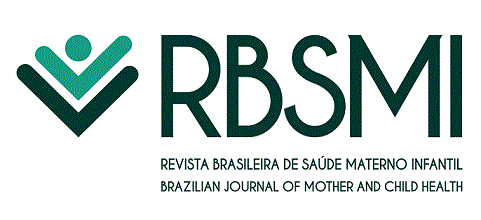Resumo em Português:
Objetivos: estimar a prevalência e investigar os fatores associados ao hábito de fumar de gestantes na cidade de São Luís, Maranhão. Métodos: estudo de corte seccional em amostra de 5212 gestantes assistidas em onze hospitais de São Luís em 2010. Informações sobre hábito de fumar e características socioeconômicas, demográficas, de saúde reprodutiva e hábitos de vida foram obtidos utilizando questionário padronizado. Estimativa da prevalência e cálculo de odds ratio (OR), com seus respectivos Intervalos de Confiança de 95% (IC95%), foram obtidos em um modelo de regressão logística. Os dados foram analisados no programa estatístico STATA 12.0. Resultados: a prevalência do hábito de fumar na gravidez foi 4,1% (IC95%:3,55-4,64). Os fatores associados ao hábito de fumar foram: ausência de religião (OR=1,58; IC95%:1,11-2,26); não ter companheiro (OR=1,66; IC95%:1,15-2,38); as categorias 2 a 4 partos (OR=2,25; IC95%:1,54-3,29) e cinco partos ou mais (OR=2,50; IC95%:1,23-5,05); 0 a 3 consultas pré-natais (OR=2,75; IC95%:1,74- 4,34); classe econômica D/E (OR=2,75; IC95%:1,22- 6,19); e consumo de álcool (OR=7,61; IC95%:5,50- 10,55). Conclusões: a prevalência do hábito de fumar foi baixa. Houve redução do tabagismo em São Luís de 5,9%, em 1997/98, para 4,1%, no presente estudo. É necessário que intervenções mais enfáticas sejam dirigidas às gestantes com os fatores de vulnerabilidade encontrados.
Resumo em Inglês:
Objectives: to estimate the prevalence and investigate the factors associated with smoking among pregnant women in the city of São Luís, Maranhão. Methods: a cross-sectional study was carried out with a sample of 5,212 pregnant women attending eleven hospitals in São Luís in 2010. Information on smoking and socio-economic, demographic, reproductive health and lifestyle characteristics were obtained using a standardized questionnaire. The prevalence was estimated and the odds ratio (OR) calculated, with respective confidence intervals of 95% (CI95%), using a logistic regression model. The data were analyzed using the STATA 12.0 software package. Results: the prevalence of smoking during pregnancy was 4.1% (CI95%:3.55-4.64). The factors associated with smoking were: lack of religion (OR=1.58; CI95%:1.11-2.26); not having a partner (OR=1.66; CI95%:1.15-2.38); having had 2 to 4 births (OR=2.25; CI95%:1.54-3.29) or five births or more (OR=2.50; CI95%:1.23-5.05); 0 to 3 prenatal consultations (OR=2.75; CI95%:1.74-4.34); economic class D/E (OR=2.75; CI95%:1.22-6.19); and alcohol consumption (OR=7.61; CI95%:5.50- 10.55). Conclusions: the prevalence of smoking was low. There was a reduction in smoking in São Luís from 5.9%, in 1997/98, to 4.1% in the present study. More emphatic interventions should be directed at pregnant women with the identified risk profile.
